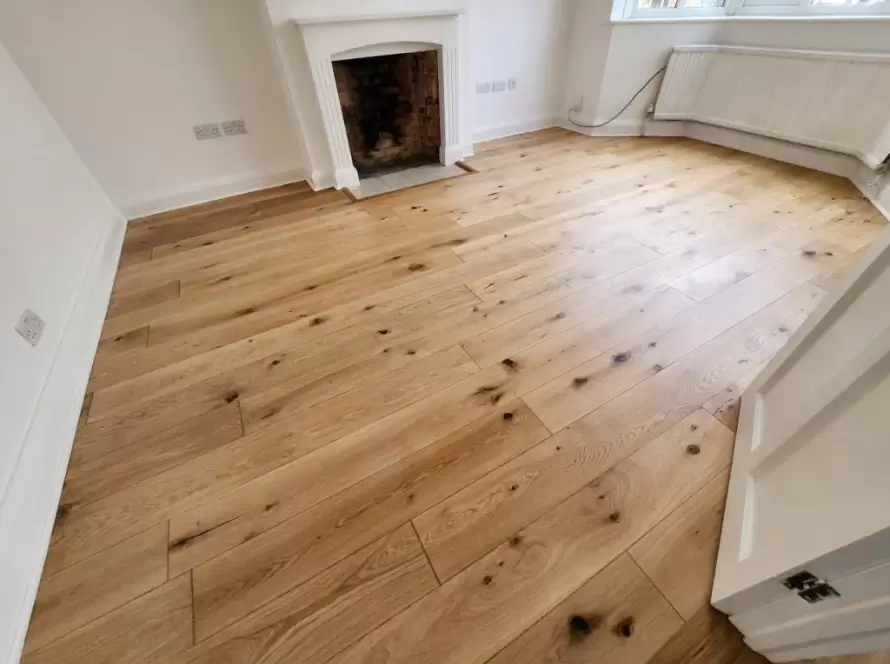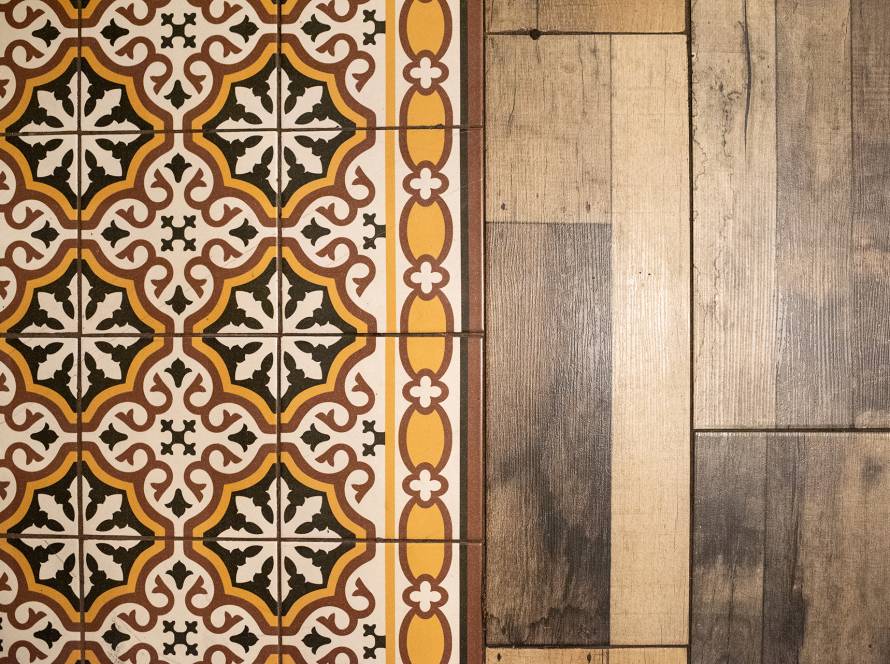Wood flooring brings a timeless, elegant touch to any interior, making it a popular choice for both residential and commercial spaces. With options like solid hardwood, engineered wood, laminate, and reclaimed wood, there’s a wood flooring solution for every style, budget, and practical need. This guide explores various types of wood flooring to help you choose the best option, including the pros and cons, ideal locations, and maintenance tips. Whether you’re after a rustic feel, a modern vibe, or a classic look, there’s a wood flooring type to meet your needs.
1. Solid Hardwood Flooring

Solid hardwood flooring is known for its natural beauty, high durability, and classic appeal. Each board is crafted from a single piece of wood and installed using a tongue-and-groove system, making it one of the most luxurious and long-lasting wood flooring options.
- Best For: Living rooms, hallways, and bedrooms where humidity levels are stable.
- Maintenance: Requires regular cleaning and occasional refinishing to maintain its shine and durability.
Pros of Solid Hardwood Flooring:
- Refinishing Capability: Solid hardwood can be sanded and refinished multiple times, restoring its original beauty and extending its lifespan.
- Durability and Value: This flooring adds value to a property and can last for decades, making it a worthwhile investment.
- Aesthetic Appeal: Solid hardwood brings warmth and elegance, enhancing any interior.
Cons of Solid Hardwood Flooring:
- Moisture Sensitivity: Humidity changes can cause solid wood to swell or shrink, which may affect its longevity.
- Complex Installation: Professional installation is recommended due to the precision and tools required.
- Higher Initial Cost: Due to the quality and quantity of wood used, solid hardwood is more expensive than some other wood flooring types.
2. Engineered Wood Flooring

Engineered wood flooring offers the beauty of solid wood with added versatility. Each plank consists of multiple layers of wood with a hardwood top layer, providing durability and resistance to humidity.
- Best For: Living rooms, bedrooms, and basements due to its stability in various environments.
- Maintenance: Requires regular sweeping and mopping, and proper care depending on the finish used.
Pros of Engineered Wood Flooring:
- Moisture Resistance: Engineered wood withstands humidity changes better than solid wood, reducing the risk of warping.
- Durable and Versatile: Suitable for installation on any level, including below ground.
- Cost-Effective Alternative: Offers a premium look with real wood at a lower cost than solid hardwood.
Cons of Engineered Wood Flooring:
- Limited Refinishing: Due to a thinner hardwood layer, refinishing is limited compared to solid wood.
- Installation Complexity: Designs can vary, making installation more complicated depending on the style chosen.
- Higher Cost than Laminate: Though more affordable than solid hardwood, engineered wood is pricier than laminate or vinyl flooring.
3. Reclaimed Wood Flooring

Reclaimed wood flooring is made from recycled wood, often salvaged from old buildings. This eco-friendly option offers unique character and rustic charm, making it highly sought after for its sustainable and vintage appeal.
- Best For: Living areas, avoiding high-humidity rooms.
- Maintenance: Requires more upkeep due to its age and previous exposure to environmental factors.
Pros of Reclaimed Wood Flooring:
- Eco-Friendly: Reclaimed wood reduces demand for new timber, supporting sustainable practices.
- Distinctive Look: Each plank has unique wear and grain, adding character to any room.
- Durable: Reclaimed wood often originates from older, high-quality timber, offering longevity and strength.
Cons of Reclaimed Wood Flooring:
- Potentially Prone to Imperfections: Due to previous use, reclaimed wood may have some blemishes or pest-related issues.
- Higher Cost than Standard Wood Options: The unique sourcing and preparation process can make it more expensive.
4. Parquet Flooring

Parquet flooring is a decorative option, often created from small blocks of hardwood laid in geometric patterns like herringbone or chevron. Parquet flooring brings a sophisticated, classic look that complements elegant interiors.
- Best For: Hallways, foyers, and reception areas where its design can be showcased.
- Maintenance: Requires regular sweeping, cleaning, and polishing to maintain its intricate patterns and durability.
Pros of Parquet Flooring:
- Elegant and Stylish: Adds a sense of luxury and warmth to spaces, increasing the home’s value.
- Durability: High-quality parquet floors last for years and withstand regular use.
- Unique Design Appeal: Parquet patterns elevate the room’s aesthetics, making it a focal point.
Cons of Parquet Flooring:
- Susceptible to Scratches: Sharp objects, such as high heels, can damage the surface.
- Fading Potential: Exposure to sunlight may cause parquet floors to fade over time.
- Frequent Maintenance: Regular polishing, sanding, and sealing are needed to keep parquet looking its best.
5. Cork Flooring

Cork flooring is a sustainable option made from the bark of the cork oak tree. Its natural softness and insulating properties make it a unique choice for residential use, particularly in bedrooms and playrooms.
- Best For: Bedrooms, playrooms, and children’s spaces where comfort is a priority.
- Maintenance: Weekly sweeping and prompt spill cleanup are essential to protect cork floors.
Pros of Cork Flooring:
- Sound and Heat Insulation: Cork absorbs sound and retains warmth, creating a comfortable environment.
- Hypoallergenic: Cork doesn’t attract dust or mites, making it ideal for those with allergies.
- Shock-Absorbent: Provides a cushioned, soft surface that withstands foot traffic.
Cons of Cork Flooring:
- Less Durable than Hardwood: Cork can be scratched and dented more easily, especially by furniture.
- Susceptible to Moisture Damage: Excessive moisture can damage cork, so it’s not ideal for humid environments.
- Shorter Lifespan: While comfortable, cork may not last as long as solid or engineered hardwood.
Factors to Consider When Choosing Wood Flooring
- Room Type: Choose flooring based on room function. High-traffic areas may need more durable options.
- Humidity and Sunlight: Humidity and direct sunlight can affect certain types of wood flooring.
- Maintenance Requirements: Some floors require more upkeep, while others are easier to maintain.
- Pets: If you have pets, choose scratch-resistant and durable wood flooring.
- Budget: Balancing cost with quality is essential to find the right fit for your needs.
- Ease of Installation: Consider whether professional installation is necessary or if a DIY option would work.
- Underfloor Heating Compatibility: Some wood floors aren’t compatible with underfloor heating.
- Design: Wood flooring comes in various patterns and finishes, so choose one that complements your interior.
Conclusion
Choosing the right type of wood flooring requires careful consideration of aesthetics, budget, durability, and the specific needs of your space. Whether you opt for solid hardwood, engineered wood, or an eco-friendly choice like reclaimed wood or cork flooring, each type brings unique benefits. At Alpha Floor Sanding Ltd, our team of experts is here to assist with selecting, installing, and maintaining wood flooring, ensuring that you achieve beautiful, long-lasting results.For professional advice and comprehensive floor sanding and restoration services, reach out to Alpha Floor Sanding Ltd. We’re dedicated to helping you create the perfect floor for your home or business.




